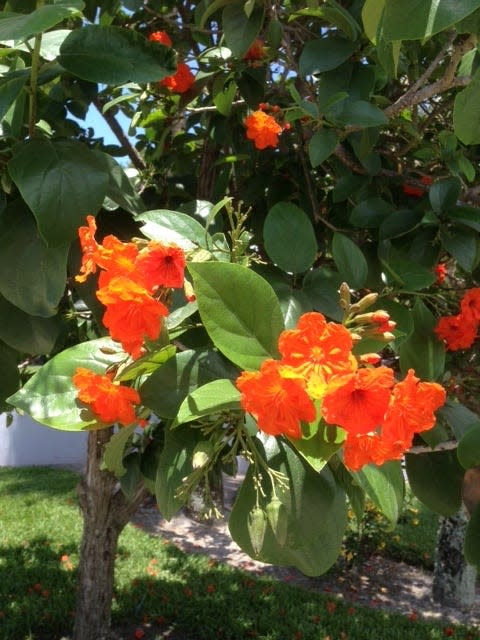Add color and shade to your Florida landscape with these flowering trees | Sally Scalera
Spring is coming, and soon many trees will bloom before their foliage emerges.
I enjoy spring, because driving by a golden trumpet tree in full bloom with its bright yellow flowers makes me happy. If you enjoy colorful flowers and summertime shade, here are some flowering trees to consider adding to your landscape.
Brief descriptions of each tree are provided to assist you in selecting the right tree for your yard.
The first five trees listed are native to Florida.
Fringetree (Chionanthus virginicus): Deciduous, 12 to 20 feet tall, 10 to 15 feet wide. White flowers are produced in the spring, followed by berries that attract birds. Grows in full sun to shade and is cold tolerant.
Coral bean (Erythrina herbacea): Deciduous, 8 to 15 feet tall, 8- to 10-foot spread. Spikes of red flowers are produced in the spring. Grows in full sun to partial shade and is salt-tolerant. Tolerates a wide range of pH, cold and drought tolerant. Attracts hummingbirds.
Sweet Acacia (Vachellia farnesiana): Semi-evergreen, 15 to 20 feet tall and wide. Small fragrant yellow pom-pom flowers produced throughout the year. Small thorns are produced on the trunk. Drought and salt tolerant. Attracts birds.

Geiger tree (Cordia sebestena): Evergreen, 25 to 30 feet tall, and 20 to 25 feet wide. Produces orange tubular flowers in the spring and summer. Grows in full sun to partial shade. High salt and drought tolerance. Attracts hummingbirds.
Southern magnolia (Magnolia grandiflora): Evergreen, 60 to 80 feet tall, 30- to 40-foot spread. Fragrant white flowers bloom spring through the summer. Extremely cold hardy (I have seen it on the Iowa State University campus!)
The following trees are not native to Florida.
Golden trumpet tree (Tabebuia chrysotricha): Deciduous with a height and spread of 25 to 35 feet. Bright yellow flowers are produced before the foliage appears in the spring. Grows in full sun to partial shade.
Purple trumpet tree (Tabebuia impetiginosa): Deciduous, 12 to 18 feet tall, 10- to 15-foot spread. Purple flowers bloom in the spring before the foliage appears. Grows in full sun. High drought tolerance.
White Geiger tree (Cordia boissieri): Evergreen, 15 to 20 feet tall, 10 to 15 feet wide. White flowers bloom year-round. Grows in full sun to partial shade. Drought and salt tolerant, and cold hardy.
Bottlebrush (Melaleuca citrina), previously called Callistemon citrinus): Evergreen, 10 to 15 feet tall and wide. Red flowers produced spring through summer. Grows in full sun. Attracts hummingbirds. High drought tolerance, cold tolerant. (The weeping bottlebrush (Melaleuca viminalis), previously called Callistemon viminalis) is considered a High Invasion Risk, per IFAS Assessment assessment.ifas.ufl.edu/assessments/melaleuca-viminalis for north, central, and south Florida, so don’t plant this species.)
Peregrina (Jatropha integerrima): Evergreen, only grows 10 to 15 feet tall and wide. Produces red flowers throughout the year. Grows in full sun to full shade. Is a nectar source for butterflies. Produces poisonous seeds.
Crape myrtle (Lagerstroemia indica) Deciduous, with numerous cultivars that range in size and flower colors, including lavender, pink, purple, red or white. Blooms spring through summer. Grows in full sun and is extremely cold tolerant.
Silver trumpet tree (Tabebuia aurea): Semi-evergreen, 20 to 40 feet tall, 15 to 25 feet wide. Yellow flowers are produced in the spring. Grows in sunny locations.
Jacaranda (Jacaranda mimosifolia): Deciduous, 25 to 40 feet tall, 45 to 60 feet wide. Fragrant lavender flowers bloom in the spring. Flowers are best in sunny locations. High drought and cold tolerance.
Golden shower (Cassia fistula): Deciduous, 30 to 40 feet tall and wide. Yellow blooms appear in the summer. Moderate salt and drought tolerance.
Yellow Poinciana (Peltophorum pterocarpum): Semi-evergreen, 40 to 50 feet tall, 35 to 50 feet wide. Fragrant yellow flowers are produced in the summer. Grows in sunny locations.
Floss silk tree (Chorisia speciosa): Deciduous, 35 to 50 feet tall, 40 to 55 feet wide. Pink and white flowers are produced in the fall and winter. Cold tolerant. A unique looking tree with large “thorns” produced on a green trunk.
Royal poinciana (Delonix regia): A tropical tree that produces red flowers and is a common throughout South Florida. Grows well on the beaches and mid- to southern Merritt Island. A freeze on the Brevard County mainland could kill it. Forms an umbrella-shaped canopy that can reach a height of 35 to 40 feet and a spread of 40 to 60 feet, so it does not belong in a small yard.
If any of these trees sound like a great addition to your yard, spring is a wonderful time to plant. To help your trees grow their best, inoculate them with mycorrhizae. If you would like more information on this topic, email the UF/IFAS Extension Brevard County Master Gardeners at brevard-mg1@ifas.ufl.edu.
Just think, when you can get flowers followed by shade, that just makes everything prettier and cooler.
Sally Scalera is an urban horticulture agent and master gardener coordinator for the University of Florida’s Institute of Food and Agriculture Sciences. Email her at sasc@ufl.edu.
More by Sally
Take steps to protect your avocado trees from laurel wilt | Sally Scalera
Amaryllis flowers can brighten any landscape; here's how to grow them | Sally Scalera
Water and mow less, plant winter flowers and veggies | Sally Scalera
This article originally appeared on Florida Today: These flowering trees do well in your Florida landscape
